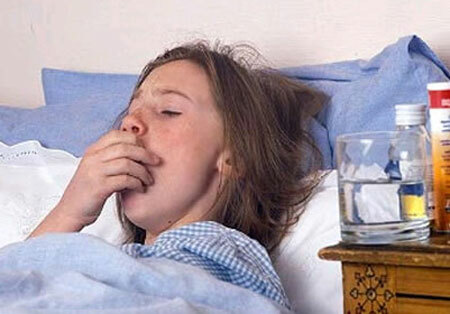Chlamydia is a group of infectious diseases, the causative agents of which are chlamydia. Pathology can equally occur in both women and men. The insidiousness of the disease is that symptoms do not appear at an early stage. In men, urogenital chlamydia is diagnosed with difficulty. Infection begins to manifest itself when the defenses of the body decrease.
Contents of
- 1 Basic information about the disease and its stages - acute and chronic
- 1.1 Video: chlamydia in men and women
- 2 Transmission routes of infection
- 3 Symptoms of
- 4 How to detect the disease?
- 5 Treatment for chlamydiosis in men
- 5.1 What medications to treat the disease - gallery
- 5.2 General recommendations
- 5.3 Traditional medicine recipes
- 5.3.1 Plant juices for strengthening immunity
- 5.3.2 Calendula tincture
- 5.3.3 Medical treatment
- 5.3.4 Flowering parsley stems
- 5.4 Traditional medicine recipes - gallery
- 6 Prognosis of treatment and possible complications
Basic information about the disease and its stages - acute and chronic
Chlamydia is aarazitarnye agents that multiply inside cells and can exist for a long time in the human body, without letting themselves know. In 50% of cases, the disease does not show any symptoms. In this case, you can get infected with an unprotected plank act. Therefore, the risk group is, in the first place, the representatives of the stronger sex who do not have a permanent partner.

Chlamydia occupies one of the first places among sexual infections in men
Chlamydia occupies one of the first places in the list of sexual infections. In addition, recently there has been a rapid increase in the incidence rate, both among the adult population and among adolescents. Early onset of sexual life, sexual intercourse with casual partners, lack of basic protective measures - all this leads to a significant increase in clinical cases of chlamydia.
There are more than 15 different types of chlamydia that can affect the eyes, lungs, lymph nodes. But the most common are the microorganisms of the genus Chlamidia trachomatis, which cause urogenital chlamydia in both sexes.
The disease can occur in acute and chronic form. The latter option is characterized by periods of remission and exacerbations. Therapy can be quite long and expensive.
Video: chlamydia in men and women
Transmission routes of infection
Due to the fact that chlamydia in most cases is transmitted sexually, the disease is most often diagnosed in sexually active members of the stronger sex between the ages of 20 and 40 years. However, there are also clinical cases among adolescents 13-17 years of age. And this is not always connected with sexual experience. There are following ways of transmission of infection:
- Contact. This includes just the same infection with sexual intercourse. In order to get a pathogenic microflora, one unsuccessful sexual intercourse is enough. In this case, the carrier may not even guess that there are chlamydia in his body. The way of transmission of infection by household means is unlikely.
- Vertical. Disease-causing microorganisms can be transmitted from mother to child during pregnancy and childbirth. In this case, the baby will not always show signs of the disease. Infection can exist for a long time in the human body and will only be felt when the body's defenses are reduced.
In rare cases, it is possible to catch chlamydia by airborne droplets when in contact with patients with pneumonia.

Chlamydia can be cloaked as a result of unprotected sexual contact with a little-known partner of
Men with strong immunity may not know about the presence of chlamydia in the body throughout their entire life. Along with this, the carrier is potentially dangerous for relatives and friends. If one of the family members has an infection, a thorough examination is recommended for everyone.
Symptoms of
The first signs of the disease may appear already two weeks after questionable sexual contact. The incubation period of the disease is 14-28 days. However, if a man has strong immunity, he can not guess the presence of pathological microflora. The risk of developing a chronic form of chlamydia increases. Often, the disease is confused with urethritis - a long-term inflammatory process in the urethra. With any unpleasant symptoms, you should not postpone the visit to the doctor, otherwise there is a risk of complications.
For acute chlamydia in men, the following symptoms are characteristic:
- rise in body temperature to subfebrile indicators;
- general weakness and increased fatigue;
- pain and burning when urinating( the first drops of urine can be cloudy);
- swelling and redness of the external urethra;
For the acute form of the disease are also characterized by pain in the groin or the area of the scrotum. Less common can be burning and itching in the area of the anus. Sometimes men can complain about meager vitreous discharge from the urethra.
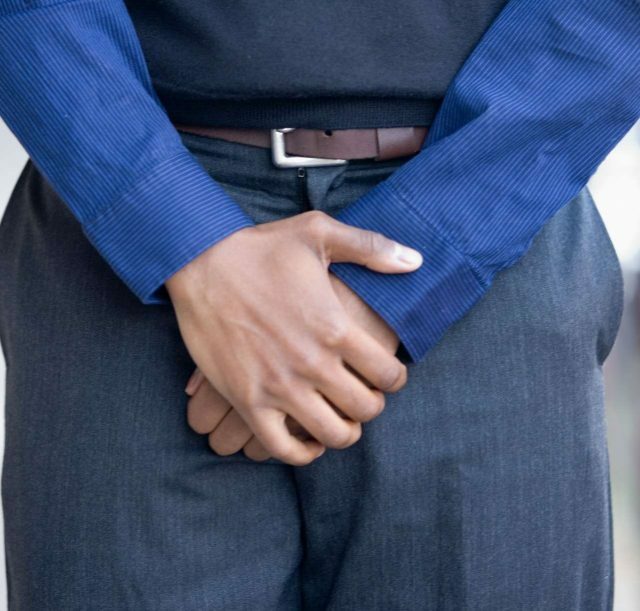
Pain in the groin area - one of the signs of chlamydiosis
In the chronic course of the pathological process, unpleasant symptoms appear only occasionally in the morning. In this case, the patient is not in a hurry to seek medical help and the disease is aggravated. Refusal of timely therapy can lead to cystitis, prostatitis, infertility.
Hidden chlamydia is a common phenomenon in men with strong immunity. Infection generally does not manifest itself at all, the patient leads a full-fledged lifestyle. Together with this, a large man is a source of infection for relatives and friends.
How to identify the disease?
If the patient does not complain of unpleasant symptoms, the infection can be detected only during the next preventive examination. If the signs of a pathological process in a patient, after all, have manifested themselves, one has to turn to a consultation with a urologist. However, one symptom only can not be diagnosed. It is necessary to differentiate chlamydia from other diseases of the genitourinary system. For this, the following methods can be used by a specialist:
- Patient survey. The urologist finds out when the first symptoms of the disease appeared, which preceded them. Men who have recently had sexual intercourse with an unfamiliar partner fall into the risk group.
- Cytological smear of the separated urethra. Wait may increase the white blood cells.
- PCR study. The specialist takes for examination soskob urogenital tract. The analysis allows you to detect chlamydia with an accuracy of 95%.
- Immunoenzyme analysis of blood. The study allows to determine the presence of antibodies to the pathogen.
- Use of direct immunofluorescence. The specialist takes a smear of the urethra, examines it for the presence of chlamydial infection.
- Bacterial sowing. The urine or sperm of the patient can be used for analysis. The study allows you to confirm the presence of chlamydia in the body, as well as to choose a drug taking into account the sensitivity of pathogenic microflora.

Only the doctor will be able to detect chlamydia after a thorough examination of
. It is important to differentiate chlamydia with other infectious diseases transmitted during sexual intercourse. Often to clarify the diagnosis requires consultation of the venereologist.
Treatment of chlamydia in men
There is no single method for treating chlamydia in men. The method of therapy is selected individually based on the clinical manifestations of the disease, the presence of concomitant pathologies, the age of the patient.
At the heart of the treatment of the disease is, first of all, the use of antibacterial agents. In this case, the drugs should be selected strictly according to the sensitivity of the pathogenic microflora. Antibiotics of a wide spectrum of action are of little effect on chlamydia.

During therapy, the disease will have to give up any sexual contacts
For treatment of the disease, the urologist chooses the drug from the group of tetracycline, macrolide or fluoroquinolines. Good results show the drugs Zitromax, Dorix, Claritomycin, Ciprofloxacin, Doxycycline, Azithromycin. The most commonly used drugs in the form of tablets or solution for intramuscular injection. In addition, antibacterial ointments for external treatment of the urethra can be used.
In addition to antibiotics in the complex therapy of chlamydia in men, the following groups of medicines are used:
- Enzyme preparations. Such medicines include biochemically active substances of animal or vegetable origin. They help increase the permeability of the body's cellular membranes. As a result, antibiotics are easier to penetrate into the cell and kill chlamydia. In addition, enzyme preparations relieve symptoms of general intoxication of the body, which is especially important in the acute period of the disease. For the treatment of chlamydia in men can use tools such as Wobenzym, Flogenzyme.
- Immune preparations. Stimulation of the body's defenses is an important part of the therapy for chlamydia. Good immunity allows antibacterial drugs to fight infection. Patients may be prescribed such drugs as Cycloferon, Amiksin.
- Vitamins. Medicines from this category allow to strengthen the immune response of the body to the invasion of chlamydia. The patient may be prescribed ascorbic acid. Glutamic acid also stimulates immunity.
- Hepatoprotectors. Enhanced drug therapy leads to disruption of the liver. Hepatoprotectors can reduce the negative impact of infection, as well as drugs on the body. In chlamydia, men can be prescribed drugs such as Karsil, Legalon, Essentiale Forte.
- Probiotics. Drugs from this category restore intestinal microflora, disrupted as a result of antibacterial therapy. Good results show the funds Lactobacterin, Lineks.
- Antiseptics. To treat inflamed areas, solutions of Chlorhexidine, Miramistin may be used. Good results are also shown by the hexicon gel. As part of complex therapy, anti-inflammatory rectal suppositories can be used.
The course of therapy depends on the clinical picture, but in most cases enough 14 days of intensive treatment to get rid of the infection. After the treatment, the patient is assigned control tests.
What medicines to treat the disease - gallery
 Chlorhexidine - quality antiseptic
Chlorhexidine - quality antiseptic 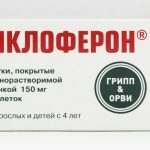 Cycloferon stimulates the body's defenses
Cycloferon stimulates the body's defenses 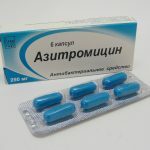 Azithromycin is an antibacterial agent that can be prescribed for chlamydia
Azithromycin is an antibacterial agent that can be prescribed for chlamydia  Lineks restores the intestinal microflora
Lineks restores the intestinal microflora  Wobenzym increases the permeability of cell membranes
Wobenzym increases the permeability of cell membranes 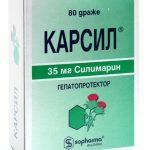 Carlsil normalizes liver activity
Carlsil normalizes liver activity General recommendations
In acute disease, a man is recommended bed rest, physicalload. Until a complete cure is necessary to exclude sex.

The correct power mode will help to speed up the recovery of
. Attention should also be paid to the power mode. A diet rich in vitamins and beneficial microelements will help to cope with the infection more quickly. Exclude alcohol, sweets. Limit the consumption of too sharp and salty foods. We should not forget the drinking regime. The patient should drink at least 1.5 liters of clean water a day.
Traditional medicine recipes
It will not be possible to cope with the disease through folk medicine alone. Self-treatment of hello to aggravation of inflammation. But in combination with traditional therapy, recipes of traditional medicine can give a good result. Many home remedies help to strengthen the body's defenses, cope with the unpleasant symptoms of chlamydia. The use of any prescription should be discussed with the attending physician.
Juices of plants for strengthening immunity
Freshly squeezed juices of plants such as ginseng, eleutherococcus, magnolia vine contribute to strengthening the defenses of the body. Treatment is carried out once a day for a month. The number of drops of freshly squeezed juice should correspond to the age of the patient.
Calendula tincture
The medication can be used for antiseptic treatment of inflamed areas. To prepare tincture, 50 g of crushed marigold flowers should be poured into 500 ml of 70% ethyl alcohol. The product should be left in a cool place for 14 days. Annual tincture should be filtered. Handle damaged areas twice a day.
Medical treatment
The following ingredients are required for the preparation of the preparation:
- 1 teaspoon of dill fruit;
- 2 tsp chopped chamomile flowers;
- 2 teaspoons of root aira;
- 2 teaspoons of cyanosis root;
- 2 teaspoons of hop cones.
All components must be thoroughly mixed, chopped in a meat grinder.100 g of raw material should be filled with half a liter of boiling water and insist in a thermos for 12 hours. Finished medicine should be filtered and taken on a third of the glass three times a day against the background of antibacterial therapy.
Blossoming parsley stalks
Faster defeating chlamydia will help a healing decoction. About 2 tbsp. Spoons of flowering parsley stems should be boiled in half a liter of water for 5 minutes. Then the finished product should be covered with a lid and leave for another 20 minutes. The medicine should be filtered and drunk during the day. Parsley stimulates the body's defenses, normalizes the intestinal microflora.
Traditional medicine recipes -
 gallery Hop cones help to cleanse the body of harmful substances and toxins
gallery Hop cones help to cleanse the body of harmful substances and toxins  Calendula flowers are used for the preparation of medicinal tincture
Calendula flowers are used for the preparation of medicinal tincture  Flowering parsley stems are used to prepare medicinal broth
Flowering parsley stems are used to prepare medicinal broth  Eleutherococcus juice stimulates immunity
Eleutherococcus juice stimulates immunity Prognosis of treatment and possible complications
With timely application formedical care forecast favorable. Adequately selected therapy allows you to overcome the infection in 2-3 weeks. But the refusal of treatment is fraught with serious complications. In men, chlamydia is the most common cause of prostatitis and subsequent infertility. In addition, the patient may experience the following pathologies:
- inflammation of the testes and their membranes;
- polyarthritis;
- cystitis;
- pyelonephritis;
- impotence.
Unpleasant consequences can have not only the disease itself, but also medical therapy. Against the background of a long reception of antibiotics, the patient may have problems with the liver or dysbiosis.

Presence of a permanent sexual partner - the main measure for the prevention of chlamydia
Chlamydia is an infection that can be avoided by observing simple preventive measures. This should include:
- the presence of a permanent sexual partner;
- use of barrier contraception for casual sexual intercourse;
- regular screening for sexually transmitted infections;
In case of detection of chlamydia in one of the partners, the treatment must go both, otherwise in the future you will again have to face unpleasant symptoms.
Chlamydia is one of the most common diseases that can be encountered in unprotected sexual intercourse with an unfamiliar partner. Problems can be avoided if you follow simple precautions and visit a urologist regularly for a preventive check-up.


